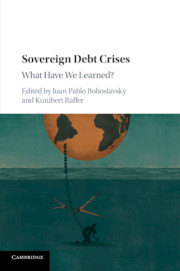Book contents
- Sovereign Debt Crises
- Sovereign Debt Crises
- Copyright page
- Dedication
- Contents
- Contributors
- 1 Introduction
- 2 Managing Public Debt Crisis in Argentina
- 3 Why Developing Countries Should Not Incur Foreign Debt
- 4 Ecuador’s 2008–2009 Debt Restructuring
- 5 Greece: An EU-Inflicted Catastrophe*
- 6 Grenada: A Small Island Developing State Needs New Ways Out of Its Debt
- 7 Iceland: A Human Rights-Sensitive Approach to Deal with Financial Crises
- 8 Indonesia’s 1997–1998 Economic Crisis
- 9 The Irish Sovereign Debt Crisis Post-2009
- 10 Short-Term Capital Controls and Malaysia’s Fast Recovery after the East-Asian Crisis
- 11 Sovereign Debt
- 12 Portugal’s Austerity Bailout
- 13 Don’t Waste a Serious Crisis*
- 14 Lessons from South Korea
- 15 The Spanish Crisis
- 16 Conclusions
- Index
11 - Sovereign Debt
Lessons from the Mexican Experience
Published online by Cambridge University Press: 16 November 2017
- Sovereign Debt Crises
- Sovereign Debt Crises
- Copyright page
- Dedication
- Contents
- Contributors
- 1 Introduction
- 2 Managing Public Debt Crisis in Argentina
- 3 Why Developing Countries Should Not Incur Foreign Debt
- 4 Ecuador’s 2008–2009 Debt Restructuring
- 5 Greece: An EU-Inflicted Catastrophe*
- 6 Grenada: A Small Island Developing State Needs New Ways Out of Its Debt
- 7 Iceland: A Human Rights-Sensitive Approach to Deal with Financial Crises
- 8 Indonesia’s 1997–1998 Economic Crisis
- 9 The Irish Sovereign Debt Crisis Post-2009
- 10 Short-Term Capital Controls and Malaysia’s Fast Recovery after the East-Asian Crisis
- 11 Sovereign Debt
- 12 Portugal’s Austerity Bailout
- 13 Don’t Waste a Serious Crisis*
- 14 Lessons from South Korea
- 15 The Spanish Crisis
- 16 Conclusions
- Index
Summary
A new borrowing cycle began after the 2008 financial crisis using bonds as instruments under the conception of low interest rates. This was true for six years, but in December 2015 interest rates began to rise in the United States, leading to a potentially difficult situation, particularly for emerging economies that do not have regional central banks to purchase their problem debts.
New debts include sovereign borrowing, state and municipal borrowing and interbank and private borrowing. This brings forth various issues: the first is the risk quality of the various bonds. The three major credit risk analysis firms separate each and every one as if they did not have the same country balance of payment support. The hypothesis is that different sub-national states have different credit ratings leading to expensive borrowing. The second issue relates to the construction of the total amount of the national debts. Using Mexico as an example, we shall attempt to review how the national debt is constructed, how the sub-national debts are included and how private international debts are taken into account. The hypothesis is that the total national debt is understated. Finally, the problems and limitations created to countries that have FTAs concerning how to manage their debts in case of default will be reviewed using Mexico as an example. FTAs have a clause that treats defaults as a violation of the contract. The clause that restricts default management gives precise instructions as to how to reorganize debts. This has far-reaching consequences at the time of debt negotiations. What debts are affected by this clause and how they are treated differently from other debts is something to be explored in the Mexican case. The hypothesis is that there are negotiation restrictions for future debt problems.
Between the 1980s and the first decade of the twenty-first century, debt instruments changed, and so have institutions. During the post-war period up to 1990 the common debt instrument in international operations were floating rate notes (FRN), defined as a variable interest, long-term debt instrument. The sovereign loan market was the euromarket, the agents were commercial banks, and the euromarket operated through syndicated loans for larger operations. After the 1990s, the euromarket operates with bonds, the agents are investment banks and creditors have turned into investors changing the debt management mechanisms. This chapter seeks to review the case of Mexico both for its historical value of the 1982 default and the 1995 crisis resolution as well as for its size as a new, emerging large capital market.
The hierarchy of the international financial architecture became manifest when problems emerged in Zaire, Jamaica, Turkey and Peru starting in the second half of the 1970s with a combination of rising interest rates and decreasing commodity prices; the IMF led the negotiations and set conditionality. This paved the way for Club of Paris and London Club settlements. The Paris Club reunited all G7 creditor countries with bilateral loans. Next in line came the London Club of private bank creditors managed by a steering committee which effectively negotiated with the debtor government in representation of all private banks. In addition, multilateral lenders had to rethink how to proceed to face the increasing risk. This led to the shift from project-based lending to policy-based lending in 1985.1 The shift in instruments and markets since the 1980’s debt crisis has led to the need of new negotiation mechanisms.
This chapter is divided in six parts: firstly, a review of the Mexican debt crisis and its management during the 1980s; this is followed by a review of the opening of the capital account in the 1990s and the emergence of new debt instruments in local currency; thirdly, a revision of the three stages of debt management after 1990; fourthly, a review of the new debt of states and municipalities and their importance; fifth an analysis of short-term capital flows that result from the previous sections; and finally some concluding remarks and lessons learnt from this case.
- Type
- Chapter
- Information
- Sovereign Debt CrisesWhat Have We Learned?, pp. 180 - 200Publisher: Cambridge University PressPrint publication year: 2017



